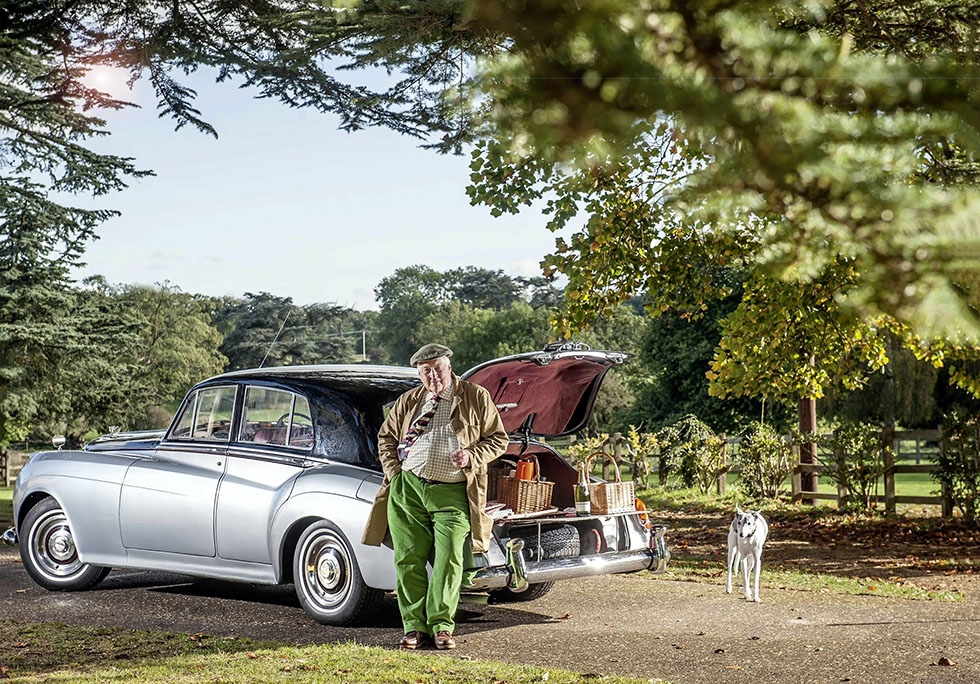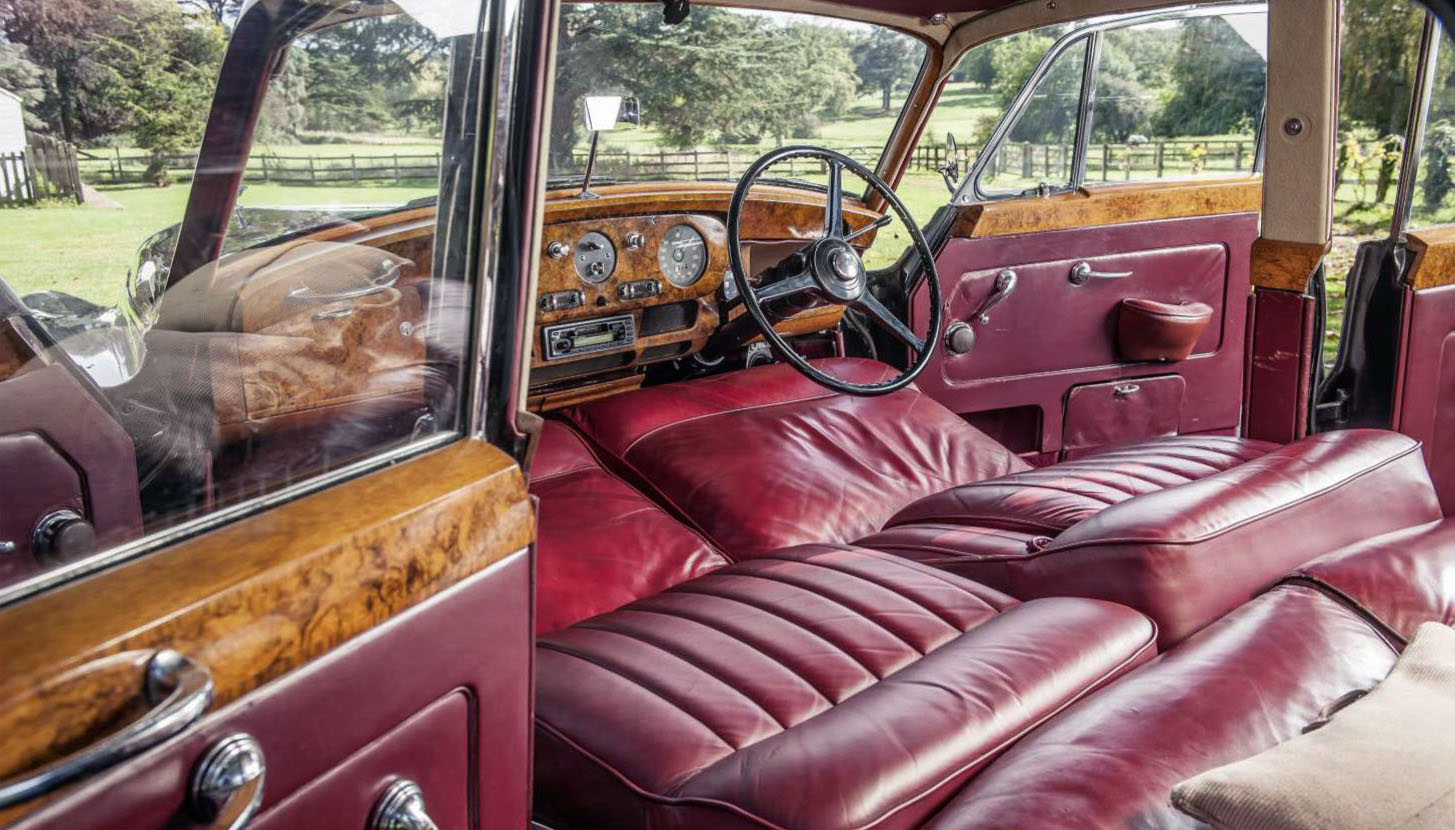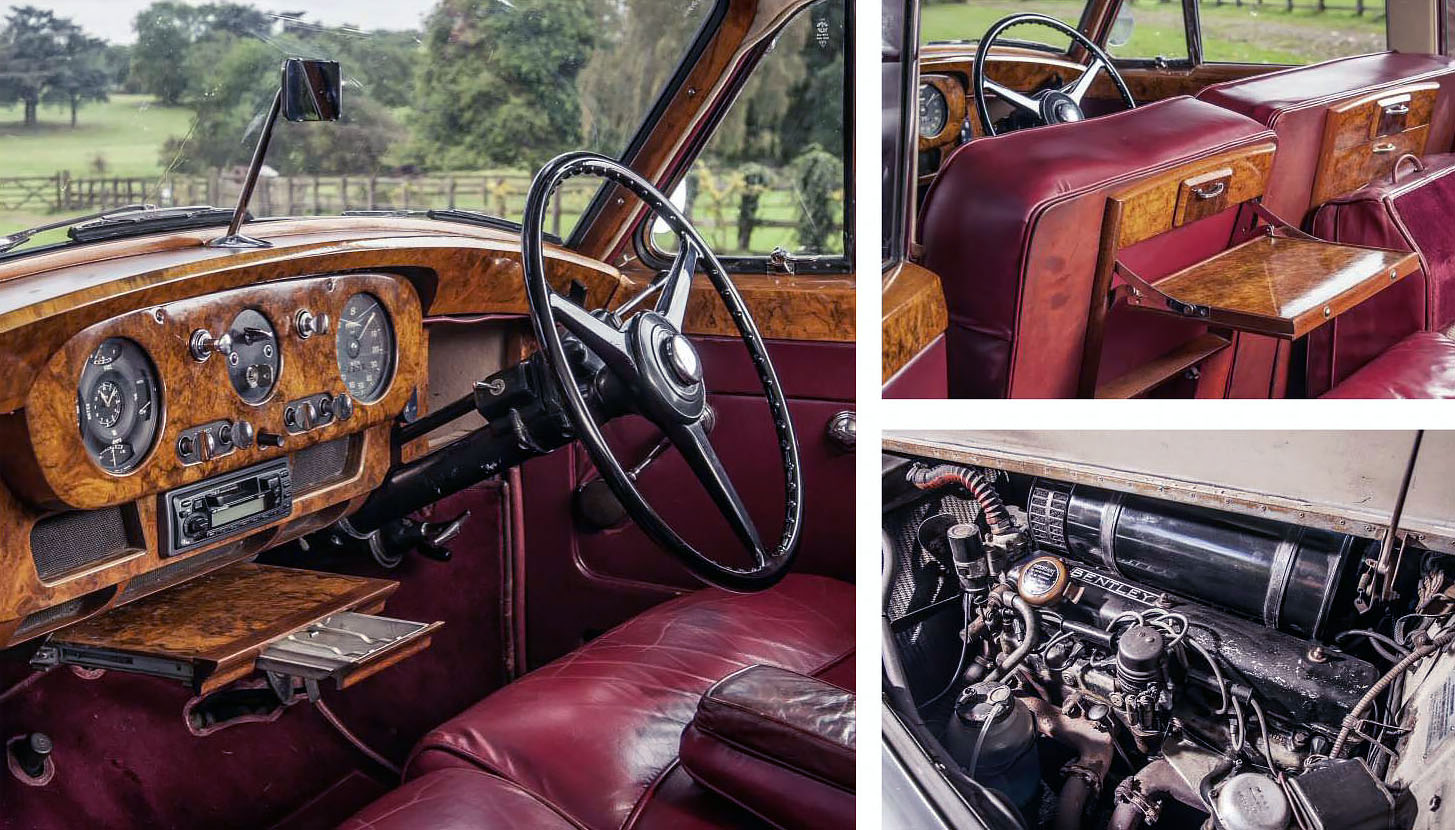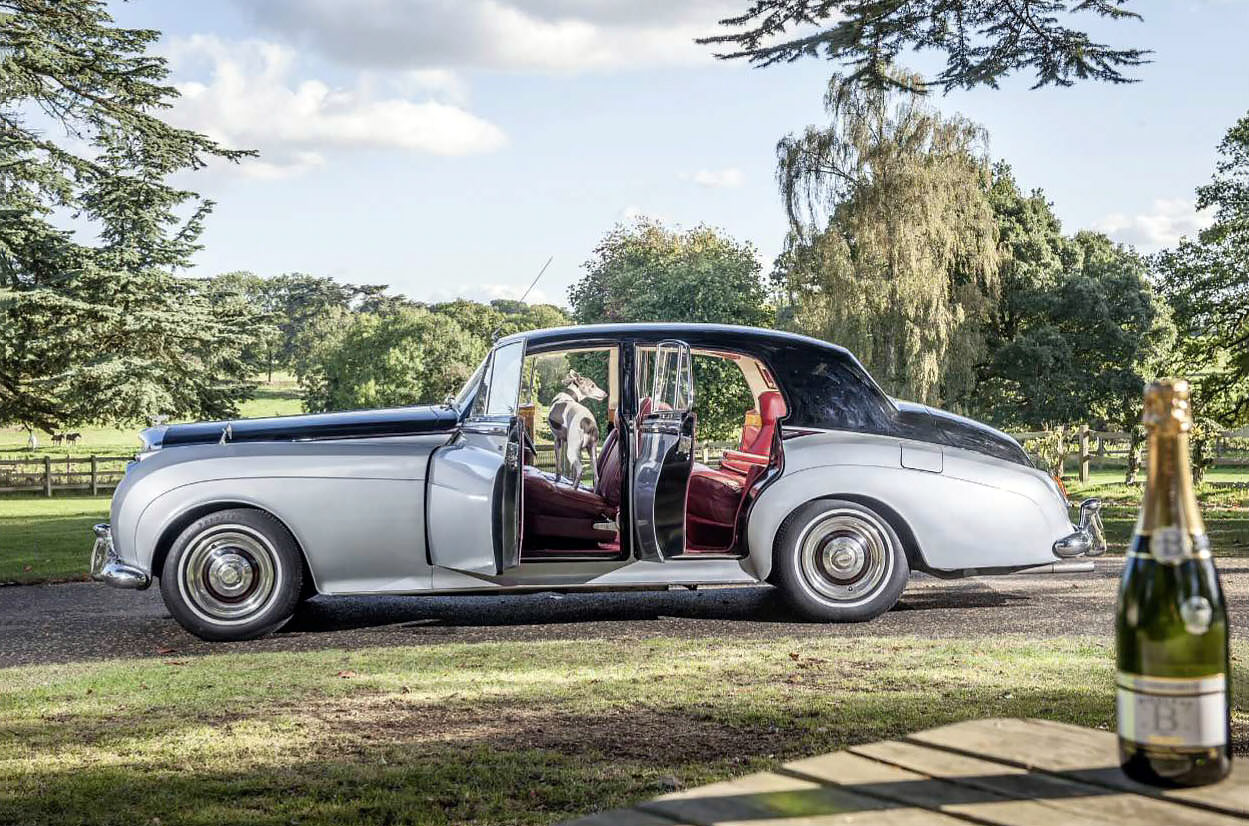
Owning 1956 Bentley S1 Countryman. Revel amid the decadent luxury of the Fifties sporting gentleman’s conversion of choice. This sportin’ life Rolls-Royce? All very well – but where’s a chap to put his fishing rods, hamper and retriever? Answer: in a Bentley Countryman. Words Andrew Roberts. Photography Laurens Parsons.
Britain was a nation in a state of rapid change 59 years ago, when this car was created. Colonel Nasser was stirring up trouble in Egypt and just when you thought Dickie Walentine was the last word in decadence along comes an American delinquent called Elvis Presley with sideburns and a hound dog obsession. At least, a new Bentley S1, converted to Countryman specification by Harold Radford of Melton Court, South Kensington offers some stability in a world that’s changing far too fast.
The 1956 car featured here is perfectly equipped for a good day’s huntin’, shootin’ or fishin’. The boot incorporates a folding table and there are compartments for bottles and glasses to celebrate a successful morning of field sports. The rear backrest folds down to create space for dogs or fishing rods. The fully reclining split backrests on the front bench permit a rest after an exceptionally good luncheon and the back seat armrest contains a vanity unit and writing accoutrements. The detailing even extends to provision for a water bottle in the driver’s door, and proud owner Richard Stancomb notes that, ‘originally there would have been a plastic bowl too – the sort of washing and shaving kit familiar to anyone who served in tanks.’

The Countryman bridged the gap between town and country with a mix of sumptuous luxury and versatile practicality.
This S1 Countryman was originally delivered to the Clement Clarke medical instrument company of London. Three years later a 1959 invoice now in Stancomb’s archive reveals that Jack Barclay sold the Bentley for £4000 (twice the cost of a new Jaguar MkIX) to Aquascutum of 100 Regent Street. Thereafter it was exported to the US, where it lived in California and Delaware. The S1 returned to the UK in 2011 and three years later Stancomb came across it at The Real Car Co in north Wales at a time when he was contemplating buying a Bentley R-type. However, he decided the R-type’s right-hand gearchange would have eventually tired him out, while the Countryman that was also on sale perfectly fitted the bill.
The man behind the Countryman, Guy Harold Radford, was originally a Rolls-Royce and Bentley dealer. In 1948 he designed a shooting brake conversion for the Bentley MkVI and bought a complete rolling chassis from Bentley Motors, commissioning specialist coachbuilder Seary & MacReady to undertake the work. The car won first prize at that year’s Cannes concours d’elégance, and two years later Radford acquired Seary & MacReady to form Harold Radford (Coachbuilders) Ltd.
Radford offered Countryman interpretations of other large British cars, but it was the Bentleys that attracted most attention and over the next seven years he refined the nature of his conversion. The advent of the R-type in 1953 allowed him to take advantage of the new car’s greater length and the Countryman now sported a discrete hatchback rather than the earlier model’s timber-clad rear bodywork. Another difference was that Radford now bought Bentleys that were almost complete, making his cars not so much coachbuilt as extensive conversions. A challenge for traditional coachbuilders was that their cars could be ruinously expensive to buy, but Radford’s decision to use standard ex-factory cars as the basis for the Countryman helped to lower prices from vast to merely steep.
In the early Fifties most Countrymen were derived from Bentleys, with only three Rolls-Royce Silver Dawn conversions. The advent in 1955 of the Silver Cloud and its Bentley S1 twin led to an even more elegant Countryman that could be ordered with 40 different options. The conversions were undertaken by HJ Mulliner & Co, with some cars boasting a split tailgate, others an extended boot and a few, such as the example here, with an exterior that belied the extensive changes within. Such quality came at a high price – Radford’s brochure lists a package of folding rear seat and ‘folding picnic table covered in Formica’ for £280, with the reclining front backrests costing £180 and the water bowl £50. Cocktail cabinets added another £60, the offside unit containing four leather-covered flasks and the nearside holding four large and four small glasses.

Fully reclining front seats added £180 to the price – equivalent to nearly £4500 today.
‘The back seat armrest containing a pigskin cigarette case, notebook, pencil, clothes brush and comb cost £25 – three weeks’ wages for the average Briton in 1956’
The back seat armrest containing ‘one pigskin cigarette case, one pigskin notebook and pencil’ plus ‘one pigskin holder containing clothes brush and comb’ cost a mere £25 – or three weeks’ wages for the average Briton in 1956. In all, the conversion cost £595 – the price of a new Morris Minor or Austin A35. Even so, sufficient clients believed it to be an inheritance well spent for Radford to offer a Countryman conversion throughout the lifespan of the Bentley S-series. My initial impression of the Countryman is that the detailing goes beyond the exquisite into the near perfect.
To complement a picnic Radford offered two small toadstool cushions that can be screwed into the rear overriders. Inside, you would not refer to a Bentley S1 as having anything as commonplace as split-folding rear seats, but seven years before the Hillman Imp made them familiar to British motorists this feature helps to make the Countryman a genuine dual-purpose car, and flicking a few levers – Countryman conversions are also easy to operate – turns a town car into comfortable and practical rural transport.
The S1’s restrained blue-over-silver body is so familiar that it’s easy to overlook how elegant it appears. Rolls-Royce began work on the Silver Cloud and its Bentley twin in 1950 under the direction of Henry Grylls, the company’s future chief engineer of the motor car division. Grylls was told to devise a new car around the familiar 4887cc engine; and John Blatchley, chief stylist of Rolls-Royce from 1950 to 1969, devised the magnificent coachwork constructed of 20-gauge steel on a box-section frame that was believed to be 50 per cent stronger than that of the preceding Silver Dawn.
This Countryman certainly feels as if it’s carved from solid steel, despite the doors, boot and bonnet being made from aluminium. The Silver Cloud/S1 used its predecessor’s coil and wishbone front suspension with a new semi-trailing configuration and the addition of a rear anti-roll bar. Opening the split bonnet reveals the B60 straight-six, as fitted to the 1954 R-type Continental but with origins dating back to the 1922 Rolls-Royce. After all, change for the sake of change would be frightfully vulgar, although the Silver Cloud is notable as being the first Rolls-Royce to have exactly the same motor as its Bentley counterpart (the Silver Dawn had one Zenith carburettor while the R-type had twin SUs).

4887cc B60 straight-six has its origins in the motor that powered Rolls-Royces back in 1922. Steering wheel needs to be this vast to manoeuvre almost two tons of Bentley with no power assistance. Modern stereo’s a temporary fitment. As well as picnic tables the rear houses cocktail cabinets and split folding.
The Silver Cloud officially debuted in April 1955 and was one of the major stars of that year’s London Motor Show, providing welcome relief from the strange new world of the Citroën DS and the ostentation of the Hooper-bodied Daimler DK400 Coupé with zebratrimmed interior. For well-heeled motorists who regarded the Silver Cloud as just the slightest bit ostentatious there was the alternative of the Bentley S1.
The earlier MkVI and R-types were advertised under the slogan ‘Take a Bentley into partnership’, the implication being that here was the ideal transport for an industrialist building a New Britain rather than a denizen of Mayfair cocktail parties. The S1’s initial advertising material was low-key to the point of being taciturn – it was a ‘new motor car representing a logical advance in the design of chassis and coachwork’. The Bentley cost £135 less than the £5079 Silver Cloud but this marginal price saving was less important than the S1’s air of discretion.
After appreciating the pleasures of Countryman’s fittings it’s time to grasp the three-spoke steering wheel and pilot the Bentley – a seemingly formidable prospect given its length and weight. However, these turn out to be foolish qualms because the S1 sets out to put you at your ease. The GM-sourced automatic transmission is standard, but the handles on the doors are charming reminders than in 1956 electric windows were only available as options, as were power steering and air conditioning. It was the US market that demanded such luxuries at a time when a Cadillac customer expected them as a matter of course, but ‘refrigeration’ and power steering were not available as options on the home market S1 until 1957.
Clearly this unassisted car was for a hardier breed of motorist, and manoeuvring the S1 at low speed is a task best left to your chauffeur because it’s akin to moving a contemporary Bedford lorry. ‘Once moving, it’s fine,’ says Stancomb – and he’s right, because as soon as the Bentley exceeds 30mph its nature is transformed, with the steering remaining heavy but becoming very well balanced, the S1 deviating from its road position not one iota. The overall impression is of being cocooned in a gentleman’s study, far removed from Nissan Qashqais, Citroën C3s and other reminders of the 21st century. The acceleration was never intended to be blistering, but by the standards of the mid-Fifties it’s more than acceptable.
Then there’s the quality of the ride, enhanced by electric rear dampers and still able to bring a party of sporting types refreshed for their G&Ts after celebrating the Glorious 12th. Approaching a T-junction I am reminded that I’m charged with bringing an awful lot of Bentley to a graceful halt with the aid of drum brakes, but my fears prove unfounded. Servo assistance means the Countryman stops as well as it drives, and my only wish was that the Ford Mondeo closely following the S1, presumably in order to fathom its marque and model, would suddenly vanish.

Comfortable enough to sleep in — handy because it cost the price of a decent house in 1956.
The Fifties was a decade when traditional British coachbuilders were facing immense challenges from the increased use of unitary bodyshells and the changing tastes of the carriage trade. Rolls-Royce designated Harold Radford (Coachbuilders) Ltd as an official coachbuilder, but in 1958 the company was acquired by the Swain Group, which already owned Rolls-Royce agency HR Owen and coachbuilder Freestone and Webb. Countryman conversions continued to be built throughout the run of the Silver Cloud/S-series, the options list eventually numbering 50 (including a dog guard), but 1963 was a watershed for the firm. It was the last year when Harold Radford had a display at the London Motor Show, and in April the coachbuilder announced its Mini Cooper de Ville conversions as ‘the most luxurious small car ever offered for prestige motoring in busy town traffic’.
The Sixties would see other Radford conversions, ranging from sublime Aston Martin DB5 and DB6 shooting brakes to the amiably bizarre PB Series Vauxhall Radford Cresta. But when the Silver Cloud and its lower-key Bentley alternatives were replaced by the Silver Shadow range in 1965 the Countryman’s era already seemed long distant. Fifty years later Stancomb, plus Clippy the dog, find the Bentley ideally suited to Wiltshire’s roads. ‘My plans for it involve bringing it up to a good but not ridiculously concours state. A lot of the work involves unbodging the bodged jobs that occurred when the car was in the US; they fouled up the demisting system, for example, and you certainly need that in this country. They also threw out the radio, but the Real Car Co gave me a Motorola unit as gift and I have had that converted to modern FM setting.’
Today the Bentley is used whenever the sun shines, a phrase reminiscent of a long-gone country where you can imagine the archetypal S1 owner fuming over his copy of The Times. There’s that ghastly trouble over the Suez Canal and any number of subversive elements – Teddy boys, people no longer standing for the National Anthem at the end of cinema bills… But with a Bentley S1 Countryman by Harold Radford all is right with the world, be it ‘in town – or out of town’.
Thanks to: The Real Car Co (realcar.co.uk)
TECH DATA 1956 BENTLEY S1 COUNTRYMAN
Engine 4887cc, in-line six-cylinder, inlet over exhaust valve, two SU HD6 carburettors
Power and torque ‘Sufficient, sir’; ‘More than adequate, sir’
Transmission Fourspeed automatic
Steering Cam and roller
Suspension Front: independent, coil springs, hydraulic dampers, anti-roll bar Rear: semi-elliptic leaf springs, adjustable hydraulic dampers, anti-roll bar
Brakes Drums front and rear
Weight 1924kg (4242lb)
Performance Top speed: 103mph; 0-60mph: 13.1sec
Fuel consumption 14mpg
Cost new £5539 (including Harold Radford conversion)
Value now £28,000
‘I plan to bring it up to a good but not ridiculously concours state. A lot of the work involves unbodging the bodged jobs that occurred when the car was in the USA’
CHOOSING A BENTLEY S1
One aspect of the S1 – or indeed the Silver Cloud – that always needs to be taken into consideration by any potential owner is rust. The front wings are especially vulnerable in the region of the firewall, as are the mounting points for the body – so a corroded Bentley will not be a cheap restoration prospect. Likewise, revitalising a tired interior calls for deep pockets. One particularly annoying problem with these grand classics is restoring a dashboard that has been ineptly and unsympathetically modified to accommodate a modern sound system.
This is a car that should stand proud – if it doesn’t this could indicate badly worn suspension. At least the challenge of rebuilding a lacklustre engine probably should be less daunting than it would be with the V8 of the subsequent S2 and S3 models. As far as the lack of PAS on the early S1s is concerned I personally found the steering quite agreeable but others may find it a tad heavy…





